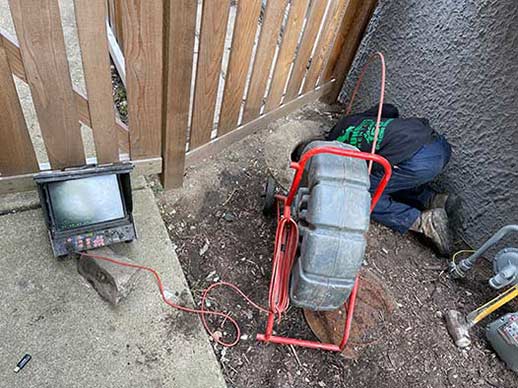
Plumbing problems can be frustrating and disruptive, but with the help of advanced technology like camera inspections, identifying and resolving these issues has become much easier.
The Benefits of Residential Plumbing Camera Inspections
Before we dive into the common issues, let’s take a moment to understand the importance of residential plumbing camera inspections. These inspections involve using specialized cameras to inspect the interior of your sewer line, providing visual evidence of any problems or potential issues.
For homeowners, the benefits of residential plumbing camera inspections are:
- Accurate Diagnosis: The cameras provide clear visuals, allowing plumbers to identify the exact location and nature of the problem.
- Cost-Effective: Camera inspections help avoid unnecessary and potentially costly repairs by pinpointing the root cause of the issue.
- Preventative Maintenance: By identifying issues early on, camera inspections can help prevent more significant problems from developing in the future.
- Time-Saving: Traditional methods of diagnosing plumbing problems involve trial and error, while camera inspections offer a quicker and more efficient solution.
Common Issues Detected by Residential Plumbing Camera Inspections
Now, let’s explore some of the common issues that can be detected through residential plumbing camera inspections:
Clogs and Blockages
One of the most prevalent issues found during camera inspections is clogs and blockages in the pipes. These blockages can occur due to various factors, such as the accumulation of grease, debris, hair, or foreign objects.
To address clogs and blockages detected during camera inspections:
- Use a plumbing snake or auger, specifically designed for clearing clogs.
- Consider using natural drain cleaners or homemade solutions to dissolve smaller blockages.
- Avoid using chemical drain cleaners, as they can damage pipes and be harmful to the environment.
- If the clog persists, it’s best to seek professional drain cleaning assistance to avoid further damage.
Leaks and Cracks
Camera inspections can detect leaks and cracks in your plumbing system that may not be visible to the naked eye. These issues can lead to water damage, mold growth, and increased utility bills.
To address leaks and cracks detected during camera inspections:
- Depending on the severity, minor leaks can be repaired using pipe clamps or epoxy putty.
- For more significant leaks or extensive damage, it’s crucial to contact a licensed plumber for professional repairs.
- Regularly inspect your plumbing system for signs of leaks, such as water stains, mold growth, or a sudden increase in water bills.
Tree Root Intrusions
Tree root intrusions occur when roots grow into underground pipes, causing blockages and potential damage. Camera inspections can reveal these intrusions, allowing homeowners to take necessary action.
To address tree root intrusions detected during camera inspections:
- Consider hiring a professional hydro jetting plumber to remove the tree roots and clear the blockage.
- Schedule regular maintenance to monitor and prevent future tree root intrusions.
- Contact an arborist to determine the best steps for managing tree roots near your plumbing system.
Corrosion and Deterioration
Over time, pipes can corrode and deteriorate due to factors like old age, water quality, or improper installation. Camera inspections allow plumbers to assess the condition of your pipes and identify areas of corrosion.
To address corrosion and deterioration detected during camera inspections:
- Consider replacing corroded pipes with more durable materials like copper or PVC.
- Regularly monitor the water quality in your area, as corrosive water can accelerate pipe deterioration.
- Ensure proper installation techniques are followed during pipe replacement or repairs.
Sewer Line Issues
Camera inspections are especially helpful in detecting problems with sewer lines, which are often buried deep underground. Sewer line issues can lead to sewage backups, foul odors, and potential health hazards.
To address sewer line issues detected during camera inspections:
- If minor blockages are detected, hydro jetting can help clear the sewer lines and restore proper flow.
- For more significant issues, such as collapsed or damaged sewer lines, it’s crucial to contact a professional plumber experienced in sewer line repairs.
- Regular maintenance, including sewer line camera inspections, can help identify potential issues before they escalate.
Wrapping It Up
Residential plumbing camera inspections are an invaluable tool for homeowners in identifying and addressing common plumbing issues. By utilizing this advanced technology, you can save time, money, and avoid unnecessary disruptions in your daily life.
Remember, if you encounter any of the issues mentioned above or suspect a plumbing problem, it’s always best to contact a plumber near you for an accurate diagnosis and appropriate solutions.

